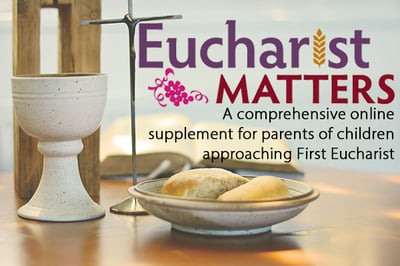The Intimacy of the Eucharist
Written by Deacon Charles Paolino
One of the many fascinating aspects of the gospels is the decisions the authors made about what details to include. Writing was a laborious process in the first century, so one can imagine that authors didn’t write any more than they thought they had to in order to effectively deliver their messages. And so, for example, when the author of John’s Gospel tells us that when Jesus sat down by Jacob’s well in Samaria “it was about noon,” he included that detail for a reason. (Many commentators say that the writer wanted to point out that the woman Jesus would encounter there had come in the heat of the day whereas most would have come in the cool of the morning.)
One such detail that may be a little off-putting at first is included in passages that describe Jesus healing men who were either blind or deaf and speech impaired. In Mark’s Gospel, we read that Jesus encountered a man who was deaf and could hardly speak. The author tells us that, in healing this man, Jesus “took him aside in private, away from the crowd, and put his fingers into his ears, and he spat and touched his tongue.” (7:33) In the same Gospel we read, “Some people brought a blind man to (Jesus) and begged him to touch him. He took the blind man by the hand and led him out of the village” and “put saliva on his eyes and laid his hands on him,” curing him of his blindness. (8:23) And in John’s Gospel we read that when Jesus saw a blind man “he spat on the ground and made mud with the saliva and spread the mud on the man’s eyes, saying to him, ‘Go, wash in the pool of Siloam’ (which means Sent). Then he went and washed and came back able to see.” (9:6-7)
We might at first recoil at any image of spitting and also at the idea of Jesus using saliva to cure these men. However, people reading these accounts in the era in which they were written might have reacted differently because of a widespread belief that saliva had healing properties. Jesus would have known that, so his decision to use saliva in these episodes—and probably in others that the gospels don’t report—wasn’t based on a desire to shock anyone.

It is also significant that, while in these and other cases Jesus in some way touched the men and women he cured—or, in the case of the woman suffering from hemorrhage, the afflicted person touched him (Luke 8:40-48)—there are also accounts in the gospels of cases in which he cured folks without touching them, cured them with his words alone. And because we know that his power to heal came from God, we also know that he could heal without physical contact.
In reflecting on this, we might bear in mind that touching another person is an intimate act that is not done casually. That idea was even more true in Jesus’ time than it is now, and it is taken seriously enough now, in our society, that it is enshrined in criminal law. Yet, Jesus often went out of his way to make physical contact, even when it wasn’t necessary. And—this is a critical aspect of our faith—he goes out of his way to make physical contact now, in all of the sacraments and, in the most intimate way, in the Eucharist. In this way, Jesus turned humanity’s relationship with God on its head, replacing a construct in which God was always at a distance from humanity with one in which God and humanity were close enough to embrace.
Our celebration of the Eucharist is usually embedded in the ritual of the Mass, which is an invaluable opportunity for us to enter into communion with Jesus and with each other, not only with those present with us at a particular Mass but also with the whole Church. The risk, however, is in seeing Holy Communion more as a ritual than as what it really is—the most intimate possible contact with Jesus in which his Body and Blood become one with our own. The risk is in coming to regard the bread and wine of the Eucharist as symbols rather than as what they really are—the true Body and Blood of Christ, Christ himself, reaching out to touch us, embrace us, become one with us. When we go back into the world after becoming one with Christ in the Eucharist, he goes with us so that, like him, we might bless whomever we touch, and especially those most in need of compassion, generosity, and justice.
This is at the heart of what it means to be a Catholic Christian, to know that in the Eucharist we are receiving the true Body and Blood of Christ, the healer, and then to go and be for the world what we have received.
Scripture references are from the New Revised Standard Version Bible: Catholic Edition, copyright © 1989, 1993 the Division of Christian Education of the National Council of the Churches of Christ in the United States of America. Used by permission. All rights reserved.
I want to learn more about Eucharist Matters.
Questions?
Contact the Development Office at 908-769-5400 ext. 104.